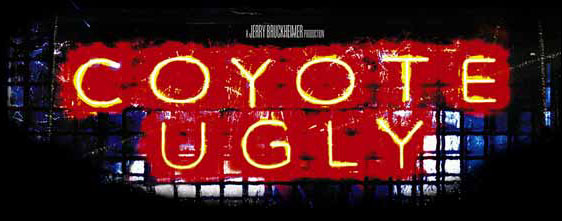
 21-year-old Violet Sanford (PIPER PERABO) heads to New York to pursue her dream of becoming a songwriter only to find her aspirations sidelined by the accolades and notoriety she receives at her "day" job as a barmaid at Coyote Ugly.
21-year-old Violet Sanford (PIPER PERABO) heads to New York to pursue her dream of becoming a songwriter only to find her aspirations sidelined by the accolades and notoriety she receives at her "day" job as a barmaid at Coyote Ugly.
A new nightclub with a twist, Coyote Ugly is the hottest spot in town, featuring a team of sexy, enterprising young women. Lil (MARIA BELLOW) is the savvy and tough proprietor with an autocratic reign over her girls, including the ever-flirtatious Cammie (IZABELLA MIKO), headstrong and antagonistic Rachel (BRIDGET MOYNAHAN) and top tip earner Zoe (TYRA BANKS). The "Coyotes" as they are affectionately called tantalize customers and the media alike with their outrageous antics, making Coyote Ugly the watering hole for guys on the prowl. Touchstone Pictures and Jerry Bruckheimer Films present "Coyote Ugly." Directed by David McNally from a screenplay by Gina Wendkos, "Coyote Ugly" is produced by Jerry Bruckheimer and Chad Oman. Mike Stenson and Scott Gardenhour are executive producers. The film is distributed by Buena Vista Pictures.
When Violet leaves her overprotective father Bill (JOHN GOODMAN), and a home in the suburbs for a 5th floor walk up in Manhattan, she suddenly finds herself desperate and broke. She spends her time diligently—writing and recording her original material, making the rounds at every label and independent record producer in town, all the while hunting for a job to pay the rent. She even attempts an open mike night at a local club, 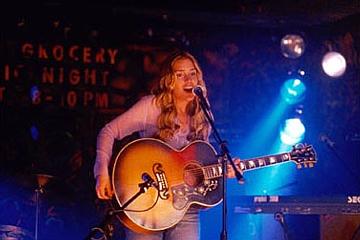 only to find that the stage fright which had always plagued her in the past still paralyzes her from performing her own songs in front of a crowd. While pounding the pavement to distribute her tape, she thinks she’s found a club manager who is interested in her music, but instead finds a genuine fan and love struck admirer in a young chef named Kevin (ADAM GARCIA). A savvy New Yorker, Kevin believes in her and offers to show her the ropes and help her with her career.
only to find that the stage fright which had always plagued her in the past still paralyzes her from performing her own songs in front of a crowd. While pounding the pavement to distribute her tape, she thinks she’s found a club manager who is interested in her music, but instead finds a genuine fan and love struck admirer in a young chef named Kevin (ADAM GARCIA). A savvy New Yorker, Kevin believes in her and offers to show her the ropes and help her with her career.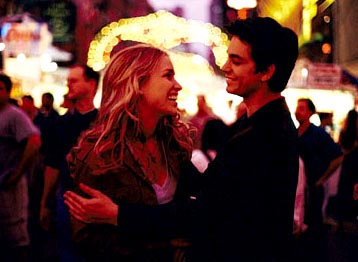
After endless rejections and she begins to focus seriously on her ultimate goal. Violet lands a job at Coyote Ugly, a saloon run by the notoriously iron-fisted maiden, Lil. Under the intoxicating influence of the bar, a watering hole that pulls in capacity crowds, Violet breaks out of her shell, using her voice and sex appeal to seize the spotlight. 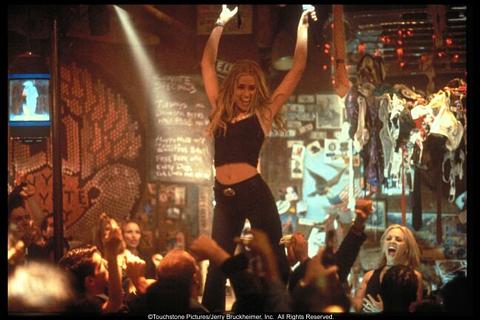 Heady from the ego boost, she fails to see that she has become nothing more than a glorified bartender -- she risks her job and loses not only the respect of her father, but true love and the chance to follow her dream. A sexy, romantic comedy featuring a spectacular soundtrack, "Coyote Ugly" is the story of one girl’s wild adventure in the big city.
Heady from the ego boost, she fails to see that she has become nothing more than a glorified bartender -- she risks her job and loses not only the respect of her father, but true love and the chance to follow her dream. A sexy, romantic comedy featuring a spectacular soundtrack, "Coyote Ugly" is the story of one girl’s wild adventure in the big city.
"This is a story about dreams," says producer Jerry Bruckheimer, 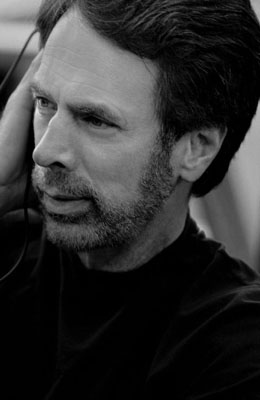 mega-producer of such hits as "Flashdance," "Top Gun," "Con Air," "Armageddon" and this year’s "Gone In 60 Seconds," of his new film "Coyote Ugly." "It’s about going after your dream and the obstacles you come up against when you’re getting close to it. With a lot of effort, a little homework and keeping your eye on the prize, you can achieve whatever it is you set out to do."
mega-producer of such hits as "Flashdance," "Top Gun," "Con Air," "Armageddon" and this year’s "Gone In 60 Seconds," of his new film "Coyote Ugly." "It’s about going after your dream and the obstacles you come up against when you’re getting close to it. With a lot of effort, a little homework and keeping your eye on the prize, you can achieve whatever it is you set out to do."
Director David McNally agrees. "It’s an emotional story, and even though it’s a comedy, the single thread throughout is this very real love story. 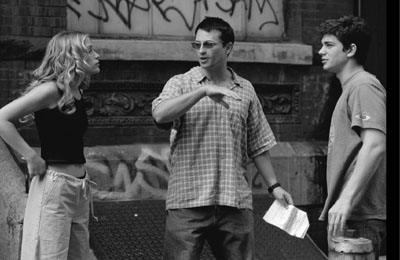 I have this belief about comedy – if you laugh at something, you’re either seeing something in yourself or learning something about yourself. If it’s communicated well, you can’t help but be drawn in by the story."
I have this belief about comedy – if you laugh at something, you’re either seeing something in yourself or learning something about yourself. If it’s communicated well, you can’t help but be drawn in by the story."
Bruckheimer, who is celebrated for his enormous success with first-time directors, tapped McNally to direct after seeing his many commercials and videos. "David’s body of work not only had a wonderful look but also a terrific sense of humor," he says. "I could tell that he was able to communicate with his actors. He was able to make fun, romantic moments out of very small gestures and seemingly innocuous circumstances; he is a great storyteller and makes unique casting choices. I was confident we could magnify that talent into an hour and a half."
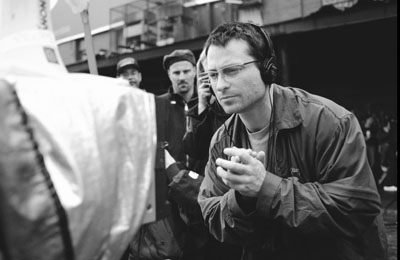 McNally was thrilled to be shooting his first feature film for Bruckheimer. "Jerry is so experienced, so knowledgeable and yet so trusting of my choices. He was incredibly supportive. I’ve learned so much."
McNally was thrilled to be shooting his first feature film for Bruckheimer. "Jerry is so experienced, so knowledgeable and yet so trusting of my choices. He was incredibly supportive. I’ve learned so much."
Although much of the mechanics in shooting commercials is the same in motion pictures, the director had to shift his mind set. "With commercials you think in terms of shots," he continues. "But with a feature, you have to think about the scene in a different way. You have 30 or 60 seconds to catch someone’s attention with a commercial, it has to be eye candy, but with a movie, it’s more about finding the reality of the scene. A film is less about designing individual shots than designing scenes."
Suggested by a GQ magazine article (March 1993) written by Elizabeth Gilbert, screenwriter Gina Wendkos created her memorable characters and a fictional story around the real Manhattan watering hole, Coyote Ugly.
"Not unlike Dorothy entering Oz, when I first stepped inside Coyote Ugly, I was terrified by the in-your-face bartenders," says Wendkos. "The terror was soon replaced by excitement as I found myself returning and returning and returning for more.
"The magic of Coyote Ugly is the female bartenders who flaunt new styles of post-feminism," she declares. "The Coyotes are all-woman, all-attitude, and instead of burning their bras, these girls hang ‘em from the rafters as a victorious statement that they own the room."
"This place, this story, it’s all about empowerment," acknowledges lead actress Piper Perabo. "These women are capable, intelligent, strong people; each in her own way. But they’re all moving toward a goal. Coyote Ugly is a vehicle to that end."
"Coyote Ugly is a great place for drama, " says Bruckheimer. "The bar itself is a fascinating venue and when you add interesting characters created from Gina’s imagination, it just comes together. Wonderful stories frequently originate with the germ of an idea. But even seemingly simple stories require attention to detail," he says. "Those ideas then have to be translated from the page and it’s always important to find the right actors. Not only individual actors but also in terms mixing personalities on screen. It was especially important in this film where the story is the relationships."
Finding the lead actress to play Violet Sanford was no easy task. The filmmakers went onworldwide search to find just the right young lady, combing 20 major cities throughout the United States and Canada with open casting calls, as well as accepting tapes from actresses and singers from as far away as Scotland. 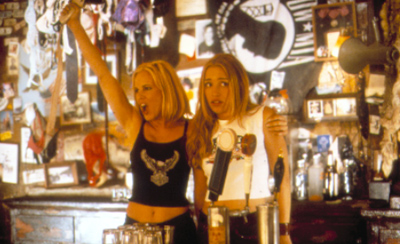
Casting director Bonnie Timmermann believed it was important to open the search as wide as possible. "I wanted to open casting for everyone," she says. "It was important to give actresses who didn’t have representation a chance to read for us. It was amazing how many videotapes came in. We followed the same process when we did ‘Dangerous Minds’ and had the most wonderful open calls. I wish we could do more of this because there are so many talented people out there who simply don’t have an opportunity to be seen."
"We left no stone unturned in finding the perfect girl," says director McNally. "She had to have that elusive something. Jerry calls it ‘movie star quality.’"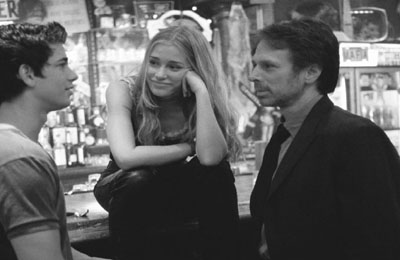
Assembling the finest cast possible is always of the utmost importance to Bruckheimer. In the press release announcing the casting call the producer was quoted as saying "Whether we cast seasoned professionals with star power or newcomers who are just breaking through, we always look for the best. It’s particularly rewarding, not to mention fun, to discover new talent. We did it with Jennifer Beals in ‘Flashdance;’ we made Tom Cruise a household name in ‘Top Gun;’ and we continue to introduce up-and-comers in each and every film we produce. This search simply continues the tradition."
After looking at thousands of young hopefuls, the filmmakers pronounced Piper Perabo the lucky winner of the part. A young actress, who had recently completed small parts in the films "The Adventures of Rocky and Bullwinkle" and "White Boys," she was unprepared for the whirlwind she was about to enter.
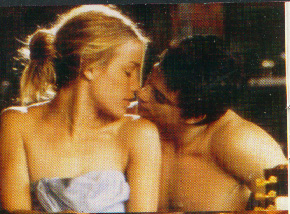 Only weeks before production began, Perabo was whisking back and forth between Los Angeles and New York for rehearsals, costume fittings, make-up and hair tests, voice coaching and recording sessions, lessons in guitar, piano, dance and even bartending, plus workout sessions. The pace never let up and continued during production. Perabo was always the consummate professional, endearing herself to the crew and filmmakers alike.
Only weeks before production began, Perabo was whisking back and forth between Los Angeles and New York for rehearsals, costume fittings, make-up and hair tests, voice coaching and recording sessions, lessons in guitar, piano, dance and even bartending, plus workout sessions. The pace never let up and continued during production. Perabo was always the consummate professional, endearing herself to the crew and filmmakers alike.
"Piper worked very hard," notes Bruckheimer. "It’s a tremendous responsibility, especially for someone so young, to carry a motion picture. I think she felt that responsibility deeply and embraced the challenge. Her work ethic and the sense of fun she brought to the set each day were inspiring to everyone."
"Piper had a real point of view about her character," says McNally. "She was prepared and thought about it. She also had an ability to read the words off the page and I believed them. She was perfect, even in some of her imperfections. She’s soft and pretty, but she’s not afraid to be a little wacky and funny. I loved the contrast. She’s very watchable."
"The first time I read the script, I was amazed because there were so many similarities between Violet and me," says Perabo. "I grew up in New Jersey and moved to New York and worked in a bar and then I got my first acting job. Violet comes from a quiet town and feels she needs to get out and experience life, which she certainly does in her first couple of days in the city.
"She has a close relationship with her father and her friends," Perabo continues. "She takes care of her father instead of the other way around and it’s hard for her to leave him."
Veteran actor John Goodman, who also worked with Perabo in "The Adventures of Rocky and Bullwinkle," plays Violet’s father, Bill. "She’s a real nice kid," Goodman says of his young co-star. "We used to call ‘em spunky in my day.
"Violet and Bill have a special bond," Goodman notes. "It’s a big, mean world out there. He prays she’s going to make it professionally, he just hopes she doesn’t get hurt. It’s every father’s hope for his little girl."
Bruckheimer looked to Goodman to anchor the film. "I thought it would be nice to have a familiar face that audiences know and like," he says. "John’s like a friend of the family. But he’s also a chameleon. He can play anything and make you believe it. That’s a wonderful actor.
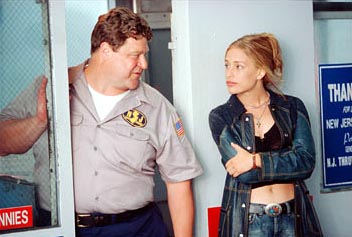 The father/daughter relationship also adds a sweetness and an innocence to the story," says Bruckheimer. "The daughter grows up and moves on – it’s a bittersweet experience for any parent. And when Violet falls in love and begins her first adult relationship, she chooses someone who is also following a dream – they’re two very similar people from different backgrounds."
The father/daughter relationship also adds a sweetness and an innocence to the story," says Bruckheimer. "The daughter grows up and moves on – it’s a bittersweet experience for any parent. And when Violet falls in love and begins her first adult relationship, she chooses someone who is also following a dream – they’re two very similar people from different backgrounds."
Not only did Adam Garcia’s handsome, athletic appeal impress the producers, but also his unique warmth and sincerity compelled them to make some changes in the character of Kevin O’Donnell. He quickly evolved into an Australian making good in America after the producers observed a genuine chemistry between Garcia and Perabo during rehearsals.
"Adam is so charming and endearing," says McNally. "And although we never thought of the character as any specific nationality, when we saw Piper and Adam working on scenes, it was so real and natural when he dropped the American accent, which he does flawlessly I might add. But when they would just talk together and joke around, it was magic."
Violet’s love interest has an eye for pretty girls and is quick with a line. "He’s a bit of a run around Joe," says Adam Garcia of his character. "I liked that. When he first sees Violet, he thinks, ‘I’ll just try my luck’ and he fails, but he keeps persisting. Then as he gets to know her, he’s taken by her dream and her talent and thinks he’s found his soul mate. She’s something he can depend on and hold onto."
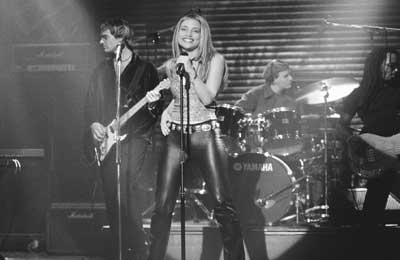 Although Violet’s best friend Gloria tries to convince her to stay in New Jersey, she is also Violet’s biggest champion. "Gloria is proud of Violet," says actress Melanie Lynskey who portrays Gloria, the quintessential Jersey girl. "She believes in Violet’s talent and is always showcasing her. She wants her friend to succeed. And even though Gloria will miss her, she admires Violet’s ability to confront the challenges ahead of her. She admires her bravery."
Although Violet’s best friend Gloria tries to convince her to stay in New Jersey, she is also Violet’s biggest champion. "Gloria is proud of Violet," says actress Melanie Lynskey who portrays Gloria, the quintessential Jersey girl. "She believes in Violet’s talent and is always showcasing her. She wants her friend to succeed. And even though Gloria will miss her, she admires Violet’s ability to confront the challenges ahead of her. She admires her bravery."
A native New Zealander, Lynskey’s accent was so convincing, many of the East Coast crew thought she was really from New Jersey.
Violet Sanford leaves her home in New Jersey to become a songwriter, but when she arrives in the big city, she can’t seem to find anyone who is interested in listening to her songs. When it’s recommended that she perform at open mike nights around town, overwhelming stage fright gets the best of her. Like the character, Perabo was inexperienced at performing in front of live audiences. It was a challenge when the actress had to sing and dance in front of dozens of extras and a large crew with several cameras following her every move.
"At first I was really scared," Perabo says. "But after a few takes, I felt better about it. I mean, they’re all directed to cheer no matter what you do. And it’s the best place to learn to sing in front of people because you can say all the wrong words, miss all your steps, fall off the bar and the place still cheers," she laughs. "It’s a pretty big confidence builder when 400 people are clapping and getting into the performance."
Although Perabo is a singer in her own right, the filmmakers' chose to embellish the lead vocals in the film by using pop phenomenon LeAnn Rimes. A uniquely versatile singer, Rimes was able to precisely tailor her voice to give added dimension to the character of Violet while maintaining the integrity of Perabo's performance.
"I love to sing, but between scene rehearsals, dance rehearsals, guitar lessons, piano lessons, bartending lessons, workouts, fittings, not to mention shooting the movie, something had to give," explains Perabo. "Jerry, David and music supervisor Kathy Nelson at The Walt Disney Studios went to a lot of trouble to find someone with a spectacular sound. LeAnn is blessed with an incredible talent. I hope everyone enjoys her rendition of Diane Warren’s original songs as much as I do."
As for many of the clientele, Coyote Ugly becomes a haven for Violet where she feels safe, but her refuge soon becomes a cage. "Initially the bar gives her the confidence she needs," says Bruckheimer. "It gives her the power to overcome her stage fright and garner a sense of self worth that lets her know no matter what, she’ll be all right.
"This bar is like a party," he describes. "It’s one of the best parties you’ve ever been to, with great music, dancing and fun people. If you’re lonely, you’ll make friends and there’s always something interesting going on. It’s also like a living room where everyone congregates and where everything happens – a lot of plot points are conveyed through the bar."
Bar owner Lil fosters the spark that is uniquely Coyote Ugly. "Coyote Ugly is an empowering place for women," says actress Maria Bello who portrays the tough talking real-life entrepreneur. "It’s down and dirty, wild and fun, and women run it. They decide whom to serve and when to do it. If the moment strikes them, they dance on the bar. At Coyote Ugly, they’re always in control."
Bello was in junior high when "Flashdance" first captivated the nation. "I’m here today largely because of that movie," she says. "I’m hoping that this story will move young people in the same way. Lil is a woman who is living her dream and inspires Violet and the other girls to go after theirs. She’s a mentor and pushes all of them to the edge, to know exactly what they want out of life."
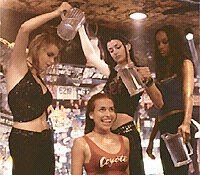 Lil’s crew includes some of the hottest girls in New York. But beauty alone won’t get you the job. It takes brains, stamina and a determined nature to earn a spot at Coyote Ugly. "It’s all about personality," declares Bruckheimer. "The girls at this bar are very sure of themselves, or very good at faking it until they truly feel that confidence. There’s also a kind of sisterhood that develops among the bartenders."
Lil’s crew includes some of the hottest girls in New York. But beauty alone won’t get you the job. It takes brains, stamina and a determined nature to earn a spot at Coyote Ugly. "It’s all about personality," declares Bruckheimer. "The girls at this bar are very sure of themselves, or very good at faking it until they truly feel that confidence. There’s also a kind of sisterhood that develops among the bartenders."
"When Violet is first finding her way at the bar, she tries to incorporate a little from each girl," says McNally. "Their roles had to compliment Violet – each role had to be identifiable and distinct. We also wanted to have a fresh new ensemble cast."
"Coyote Ugly" is the major motion picture debut for each of the beautiful young actresses who make up Lil’s proteges (with the exception of Tyra Banks who performed in John Singleton’s critically acclaimed "Higher Learning"). Like their characters, "Coyote Ugly" is the beginning of a dream come true for all of them.
Beautiful Bridget Moynahan plays Violet’s nemesis, the headstrong, pugnacious Rachel. "Rachel is Lil’s right hand man," says Moynahan. "Her dream is to run the bar sometime in the future and she doesn’t like that Violet’s just passing through. And when someone can’t hold their own it affects everyone’s tips and Rachel’s livelihood. Violet’s threatening to her on several levels."
Lil hires Violet to replace one of her best employees and top tip earners, Zoe. Played by Tyra Banks, Zoe leaves the bar after saving enough cash to put herself through law school.
"Their job is to entertain," says Banks of the bartenders. "It’s a place that allows people to have fun and escape. The girls get up on the bar and dance and jam with the customers. For Zoe, Coyote Ugly is a place to make money for law school, while having fun and being with her friends."
Polish actress Izabella Miko plays the ever-flirtatious Cammie. "Coyote Ugly" was the first American script she read. "I think I came in on four auditions, which were all a lot of fun because we had to dance. Even though I love to dance, I think what we do in the bar is a bit exaggerated. But since it’s such a crazy place, we’re trying to shock people and give them a reason to go there, a reason to pick this bar over hundreds of others out there, and we don’t even mix drinks! We just sell beers and straight shots. My character isn’t really thinking about the future. She’s just having fun, making a lot of money and falling in love constantly."
In order to make the bar scenes appear realistic, the actresses spent weeks before production as well as hours during shooting, studying the art of the fast pour, finessing the bottle twirl and learning other essential bartending techniques. Jennifer Curran, a respected bartender, was tapped as the film’s technical consultant and acted as an extra barmaid when the bigger dance sequences were being filmed.
"We always try to draw the audience in with authentic portrayals of life," says Bruckheimer. "We hire experts no matter if we’re making a film about astronauts, NSA agents or bartenders. A picture about a bar sounds simple, but the girls had to know how to pour drinks, how to flip bottles, how to deal with overzealous customers. They had to know what it felt like to have this job."
"Bartending at Coyote Ugly is an interactive sport," says Curran. "It’s all about making tips, and no one gets away with not tipping. It’s a huge mistake if you don’t and the girls ‘attack’the customer. That’s part of the atmosphere," she laughs. "So a lot of the training was about how to be aggressive and athletic. I wanted to make them sweat – if they had to fill up ice buckets and haul them to the other end of the bar, then that’s what they were going to do, nothing half way. It was like boot camp."
The filmmakers also hired choreographer Travis Payne to train the coyotes. His job was to create dance numbers and coach the girls without making them look like professional dancers.
"The first step was to rehearse with each woman individually to find out what her strengths and weaknesses were," he says. "Then my assistant Stacy [Walker] and I put together a combination for each woman and once Jerry, David and music supervisor Kathy Nelson selected the music, we took the choreography they already knew, rearranged it and made individual numbers for each of them."
Despite the limitations dancing on a bar imposed, Payne was not daunted. "Any limitations were in our minds. We were able to design great shots and make the women feel confident – so they wouldn’t fall – and just went at it. They hang from the ceilings, dive out and surf into the crowd, it was crazy, but we paid a lot of attention to detail. It’s supposed to be more about fun than eroticism."
"There’s a fine line and we were vigilant in protecting it for those PG-13 audiences," says Bruckheimer about the sensuality of the film. "In costuming, we were going for a look that flattered each woman," he notes "Obviously we wanted the girls to look good but we wanted each of them to be comfortable. We wanted a contemporary wardrobe but not anything that was too trendy because trends these days change so fast."
Bruckheimer and McNally turned to costume designer Marlene Stewart who was simultaneously working on "Gone in 60 Seconds." For years Stewart worked with Madonna and other music and motion picture icons to create looks that would influence fashion and popular culture for years to come.
"Fashion is always being recycled," says Stewart. "Right now it’s a reinterpreting of the ‘70s. Kids are updating what their parents wore. And the media is so prevalent in forming images, with MTV and magazines, that kids today are very aware of what’s going on.
"I try to experiment with colors and silhouettes, always keeping in mind where the story is going," she says of creating a style for the film. "Jerry was very explicit in giving me guidelines for each character, particularly Violet. She is an innocent small town girl who goes through a transition and becomes more sophisticated and finds her own artistic center. The real challenge is to interpret that visually.
"I never ask anyone to wear something they’re uncomfortable in," Stewart declares. "But I do try to get them to stretch a little bit if they’re not used to seeing themselves in something, because it may fit the character. But if it’s not going to enhance the performance, it’s unacceptable."
Stewart was also faced with another challenge – to make the clothes flexible enough for the strenuous dance numbers. "We created a lot of the garments prior to the choreography being set and when the dances became very athletic and extreme, we had to accommodate for that. We essentially recreated wardrobe, which could stretch and stand up to the special effects we used and still look good for the rest of the scene. We used a lot of stretch leather, which unlike real leather, has memory, and that gave us a good return."
"We created a lot of the garments prior to the choreography being set and when the dances became very athletic and extreme, we had to accommodate for that. We essentially recreated wardrobe, which could stretch and stand up to the special effects we used and still look good for the rest of the scene. We used a lot of stretch leather, which unlike real leather, has memory, and that gave us a good return."
Although the clothing is adventurous and a little sexy, director David McNally insists the clothes don’t make the sex appeal. "Of course the girls look sexy, but their sexuality doesn’t come from the clothing," he says. "It comes from their power and their bravado and their confidence, not the other way around. That had to be reflected in the wardrobe."
The bar and Violet’s apartment were assembled on stage in Playa Vista. Other locations in Los Angeles, West Hollywood, Pasadena and San Pedro were also used.
The real Coyote Ugly, located on 1st Avenue in the heart of the East Village in New York City has been around for over 10 years. Although the fictional bar depicted in the movie is somewhat similar in design to the original, production designer Jon Hutman and set decorator Rosemary Brandenburg visited many establishments in Manhattan and surrounding areas as well as other venues outside New York to devise the look of the bar.
"We must have visited 120 bars," says Hutman. "We had research sent to us from Chicago, New Orleans, Austin and even a place in Montana. There was even a point where we thought we wanted to shoot the bar in a practical location in L.A., so we scouted at least 60 bars in L.A. But Los Angeles doesn’t really have a bar culture like those other cities do.
"We tried to get at the essence of a gritty, down and dirty place where you go to hang out and have a great time – it’s almost an anachronism," he says. "But if we could create something like that, the place in itself would become an event."
But the question remained -- how does a designer create something that feels like the ultimate neighborhood bar, when the neighborhood is, in fact, the entire city? The population at Coyote Ugly is really the crossroads for bikers, stockbrokers, models, wannabe’s, students. Everybody feels comfortable in this place; it’s the great leveler.
Hutman and Brandenburg started with various layers using a rough industrial framework, raw, exposed brick and cast iron columns and beams set against a beautiful bar and back bar. "But the finish on it is cracked and crumbling," Hutman further describes. "As the backstory goes, Lil found this place, dusted it off and left it the way it was, embracing the history of the place and embellishing it with all of this found stuff that felt like what you would have if you visited every great bar in the country. We borrowed elements from each of the places we visited in terms of set dressing – bumper stickers, pictures, we did a big logo on the wall out of beer bottle caps that says Coyote Ugly. Rosemary did what Lil would have done, which is to take this old, run down place we created and fill it with all that great stuff which gives it the kind of warmth and texture that makes it totally unique.
"I call this style ‘rings of a tree,’" he says. "The style reveals the history of the place, of the people who have been there before and somehow forecasts people who will come. It makes drinking a timeless social event and it makes the place in all of its reality, a special place where people want to be."
The film’s music although peppered with staples from the ‘70s, ‘80s and early ‘90s is replete with contemporary tunes as well. Multi-award winning singer/songwriter Diane Warren wrote four original songs for the film: "But I Do Love You," "Right Kind of Wrong," "Please Remember" and "Can’t Fight the Moonlight."
Warren first worked with producer Jerry Bruckheimer on "Con Air" and wrote, "How Do I Live?" for the film. Not only did it shoot to number one for singer Trisha Yearwood, it also earned Grammy nominations for Yearwood as an artist, for Song of the Year and Song Written Specifically for a Motion Picture, as well as an Oscar® nomination for Best Original Song. "How Do I Live" was recorded by LeAnn Rimes and went triple platinum.  The song also carries the distinction of being the longest running song in the history of Billboard’s Hot 100 Chart. Warren also wrote the award-winning title song "Don’t Want to Miss a Thing," sung by Aerosmith for "Armageddon." This number one song also hit the top of the country charts for recording artist Mark Chestnutt.
The song also carries the distinction of being the longest running song in the history of Billboard’s Hot 100 Chart. Warren also wrote the award-winning title song "Don’t Want to Miss a Thing," sung by Aerosmith for "Armageddon." This number one song also hit the top of the country charts for recording artist Mark Chestnutt.
Three new bands are also featured in the film – Chalk Farm, Unwritten Law and Next Door. Music is always an important element in producer Bruckheimer’s films. "It’s something that embellishes the story," he says. "And in this film it enriches our understanding of the main character. The songs tell the audience about her trials and tribulations – about the hopes and dreams of many young people, about heartache and newfound love and about failure and success. "This film, like many of the others we’ve made, is about personal relationships," the producer says. "The theme in all of our movies revolves around people on a journey to achieve a goal. ‘Coyote Ugly’ is ultimately about Violet’s will to succeed and her emotional triumph."



© 2000-2002 Rachel and Nicki. All Rights Reserved.